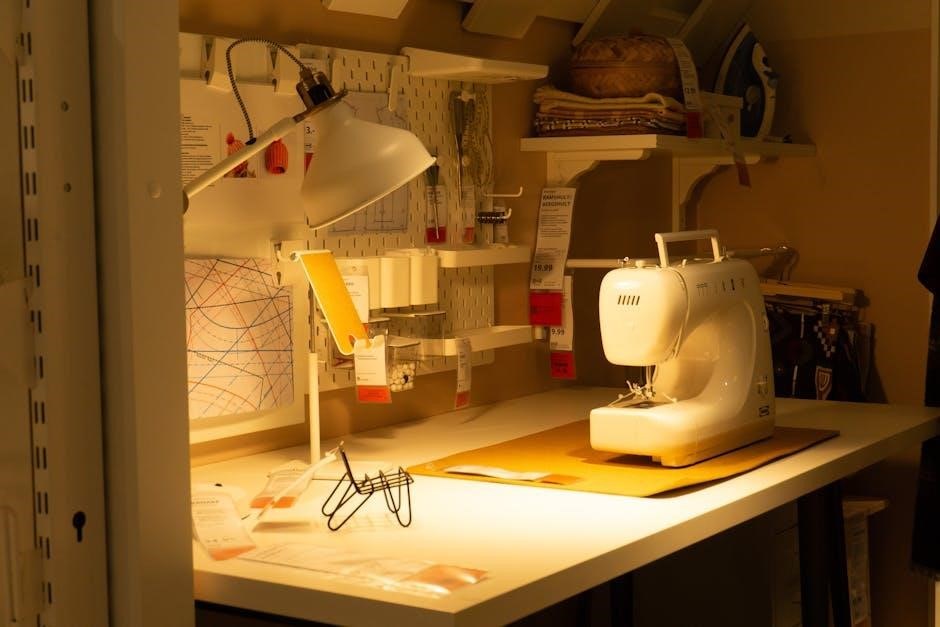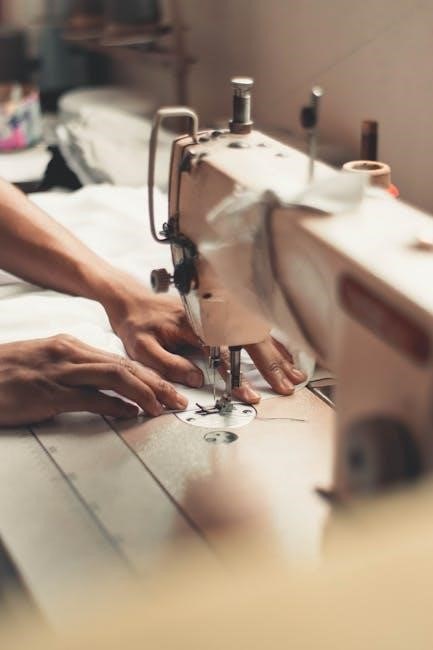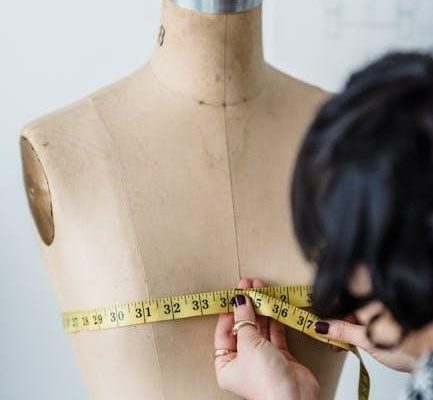The Readers Digest Complete Guide to Sewing is a comprehensive resource for sewers of all skill levels, offering step-by-step techniques for creating clothes, home accessories, and more. It covers essential tools, fabric handling, and creative projects, making it a must-have for beginners and experienced sewers alike.
1.1 Importance of Sewing
Sewing is more than just a practical skill; it is a creative outlet and a valuable life skill that empowers individuals to craft and repair their own garments and home accessories. The ability to sew fosters self-sufficiency, allowing people to create custom pieces that fit their personal style and needs. It also promotes sustainability by extending the life of fabrics and reducing waste. Additionally, sewing enhances problem-solving skills and attention to detail, as it requires understanding patterns, fabrics, and stitching techniques. The Readers Digest Complete Guide to Sewing emphasizes these benefits, providing a foundation for both beginners and experienced sewers to master essential skills. By learning to sew, individuals can save money, express their creativity, and develop a sense of accomplishment from creating something with their own hands. This timeless skill is not only a hobby but also a valuable asset for everyday life, offering endless possibilities for personal and home projects.

1.2 Benefits for Beginners
For those new to sewing, the Readers Digest Complete Guide to Sewing offers a wealth of benefits, providing a clear and accessible introduction to this versatile craft. Beginners can gain confidence through step-by-step instructions and visual guides, such as the over 2,000 drawings and photographs included in the guide. These resources help demystify complex techniques, making it easier for novices to understand and master basic stitches, fabric handling, and pattern reading. The guide also emphasizes the importance of essential tools and supplies, ensuring that learners are well-equipped from the start. By starting with simple projects, beginners can gradually build their skills, developing a strong foundation in sewing. This approach not only accelerates the learning process but also fosters creativity and a sense of accomplishment. The guide’s comprehensive coverage ensures that beginners feel supported every step of the way, turning sewing into an enjoyable and rewarding experience rather than an intimidating task.
1.3 Brief Overview of the Guide
The Readers Digest Complete Guide to Sewing is a detailed and user-friendly resource designed to cater to sewers of all experience levels. It provides a wide-ranging exploration of sewing techniques, covering both woven and knit fabrics, and includes over 2,000 drawings and photographs to illustrate key concepts. The guide is structured to help learners progress smoothly, starting with basic skills like understanding tools and supplies, such as irons, scissors, and sewing notions, before moving on to more advanced techniques. It emphasizes the importance of proper fabric handling, pattern reading, and seam allowances, ensuring a solid foundation for any sewing project. Whether the goal is to create custom clothing or craft beautiful home accessories, the guide offers step-by-step instructions to guide users through every stage. Its comprehensive approach makes it an invaluable companion for anyone looking to master the art of sewing, providing both practical advice and creative inspiration.

Tools and Supplies
The Readers Digest Complete Guide to Sewing emphasizes essential tools like scissors, pins, measuring tapes, and sewing machines. It also covers must-have supplies such as fabric, threads, needles, and notions, ensuring a smooth sewing experience.
2.1 Essential Hand Tools
Essential hand tools are the foundation of any sewing project. Scissors are a priority, with dedicated pairs for cutting fabric and smaller ones for trimming seams. Pins are indispensable for securing fabric, while glass-headed pins are safer near irons. A sewing needle set offers various sizes for different tasks. A tape measure ensures accurate measurements, and a seam ripper helps correct mistakes. Thimbles protect fingers from needle pricks, and a pin cushion keeps supplies organized. These tools are vital for efficiency and precision in sewing. They allow beginners to handle fabric confidently and achieve professional results. Investing in quality tools enhances the sewing experience and ensures durability. By mastering these basics, sewists can tackle projects with ease and creativity. These hand tools are the first step toward mastering the craft, providing the means to bring ideas to life. Proper care and storage of these tools extend their lifespan, making them a long-lasting investment in your sewing journey.
2.2 Sewing Machine Essentials
A sewing machine is a cornerstone of modern sewing, and having the right accessories ensures optimal performance. Start with a reliable sewing machine, choosing one that suits your skill level and project needs. Presser feet are crucial for various tasks, such as zigzag, zipper, and buttonhole stitching. A selection of machine needles is vital, as different fabrics require specific needle types. Bobbins are essential for winding thread, and having extras ensures uninterrupted sewing. Lint brushes and oil are necessary for routine machine maintenance to prevent dust buildup and keep parts lubricated. Additionally, a machine carrying case protects your investment during storage or transport. These essentials enhance your sewing experience, allowing you to tackle projects efficiently. By understanding and utilizing these machine-specific tools, you can unlock your sewing machine’s full potential. Regular maintenance and the right accessories ensure smooth operation and professional results. Investing in quality machine essentials is key to mastering the craft and achieving lasting satisfaction in your sewing journey. Proper care and organization of these items are indispensable for any serious sewist.
2.3 Notions and Accessories
Notions and accessories are indispensable for bringing your sewing projects to life. Notions include small items like buttons, snaps, hooks and eyes, zippers, and thread. These are often overlooked but are crucial for finishing garments and home decor items professionally. Buttons, for instance, come in various shapes, sizes, and materials, each suited for different fabrics and uses. Snaps and hooks and eyes are ideal for closures that require ease of use. Zippers are essential for bags, jackets, and other items needing secure openings. Thread is a fundamental notion, available in a spectrum of colors to match any fabric. Accessories, on the other hand, enhance your sewing experience. Scissors and rotary cutters are vital for precise fabric cutting. Measuring tapes and rulers ensure accuracy, while seam rippers help correct mistakes. Ironing supplies, like a good iron and ironing board, are essential for pressing seams. Having the right notions and accessories streamlines your workflow and elevates the quality of your projects. They are the finishing touches that make your creations both functional and beautiful, ensuring every stitch and detail is perfectly in place.

Sewing Techniques
Sewing techniques form the foundation of successful projects, from basic stitches to advanced methods. They ensure durability, precision, and a professional finish, making every creation both functional and visually appealing for years to come.
3.1 Basic Stitches
Mastering basic stitches is essential for every sewer, as they form the foundation of all sewing projects. The running stitch, the most straightforward, is used for gathering fabric and basting. The backstitch is ideal for heavy fabrics and creates a strong, visible line. The slip stitch is perfect for closing seams invisibly, while the blind hem stitch is great for hemming without visible stitching. The whipstitch is handy for finishing raw edges and seaming two pieces together. Each stitch serves a unique purpose and understanding their applications ensures professional-looking results. Practice these stitches regularly to build confidence and improve your sewing skills. With time and patience, these stitches will become second nature, allowing you to tackle more complex projects effortlessly. Start with these basics and watch your sewing skills flourish!
3.2 Working with Patterns
Working with patterns is a fundamental skill for sewers, enabling the creation of precise, well-fitted garments and projects. Patterns serve as templates, guiding the cutting of fabric to achieve the desired shape and design. They are available in various forms, including printed tissue paper, digital files, and custom-made designs. Understanding how to read and use patterns is crucial for success. Start by identifying key components such as pattern pieces, cutting layouts, and markings like grain lines and notches. Grain lines ensure fabric stretches correctly, while notches help align pieces accurately. Always match the fabric grain to the pattern grain for professional results. Cutting accurately is essential, as mistakes here can affect the final fit. For beginners, it’s wise to start with simple patterns and gradually move to more complex designs. Advanced sewers can explore custom patterns or alterations to create unique pieces. Whether using store-bought or self-drafted patterns, mastering this skill opens the door to endless creative possibilities in sewing. With practice, working with patterns becomes second nature, enhancing your sewing journey. Patterns truly are the blueprint for bringing your sewing visions to life.

3.3 Seam Allowances and Finishing
Seam allowances and finishing are critical steps in sewing that ensure durability and a professional finish. A seam allowance is the extra fabric between the stitching line and the raw edge of the fabric. Standard allowances range from 1/4 inch to 5/8 inch, depending on the pattern or project. Proper seam allowances prevent fraying and ensure a smooth fit. Once seams are sewn, finishing them is essential to prevent the fabric from unraveling over time. Common finishing techniques include zigzag stitching, serging with an overlock machine, or binding the edges with bias tape. For a crisp, polished look, pressing seams with an iron is a must. This step helps the fabric lie flat and creates a professional appearance. Additionally, topstitching can be used to reinforce seams and add decorative detail. Always use the correct tools, like a seam ripper, to carefully remove any mistakes without damaging the fabric. By mastering seam allowances and finishing, you can create garments and home decor items that are both functional and visually appealing. These techniques are foundational for achieving high-quality results in every sewing project.

Working with Fabrics
Working with fabrics requires understanding their types, textures, and properties. Proper preparation, like pre-washing and ironing, ensures accurate cutting and stitching. Matching patterns and grains is crucial for professional results. Master these steps for successful fabric handling and common challenges.
4.1 Types of Fabrics
Fabrics come in a wide variety of types, each with unique characteristics and uses. Natural fabrics, such as cotton, linen, and silk, are breathable and often ideal for beginners. Cotton is durable and easy to work with, making it perfect for everyday projects. Synthetic fabrics like polyester and nylon are strong and low-maintenance, often used for activewear and home decor. Blends, which combine natural and synthetic fibers, offer balanced properties like softness and durability.

Knit fabrics, such as jersey and fleece, stretch and are great for garments like T-shirts and leggings. Woven fabrics, including denim and chiffon, are stable and suitable for structured projects. Specialty fabrics like velvet and lace add elegance to sewing projects, while canvas and muslin are versatile for crafts and prototypes.
Understanding fabric types helps you choose the right material for your project, ensuring the best results. Always consider factors like texture, drape, and care requirements when selecting fabric.
4.2 Cutting Fabric
Cutting fabric is a critical step in sewing, requiring precision to ensure accurate results. Always start by washing and ironing your fabric to remove any shrinkage or wrinkles. Use sharp tools, such as rotary cutters or scissors, to achieve clean cuts. A self-healing mat and ruler are essential for straight edges and precise measurements.

When cutting, align the fabric grain lines with the pattern pieces to maintain stability and prevent distortion. Pin or weigh patterns firmly to keep them in place. For symmetry, fold fabric as indicated in the pattern, and cut through all layers evenly. Use notches and markings to guide accurate cuts, especially for complex shapes.
Work in a well-lit area and double-check measurements before cutting. Avoid stretching or pulling fabric, as this can misshape the material. For curved edges, use shears or a rotary cutter with a curved blade. Label cut pieces for easy identification later. Cutting fabric accurately ensures a professional finish and a successful sewing project.
4.3 Matching Patterns
Matching patterns is a crucial skill in sewing, especially when working with printed fabrics. Proper alignment ensures a professional finish and prevents the garment from looking misaligned or unpolished. Start by identifying the pattern repeat—the distance between identical design elements. This information is usually found on the selvage edge or in the fabric description.
To match patterns effectively, ensure that the design aligns at seams and joints. Use a ruler or measuring tape to mark key points on the fabric, and align these with the pattern pieces. For symmetrical designs, fold the fabric along the lengthwise grain and cut mirrored pieces simultaneously. This ensures that the pattern appears continuous.
When cutting, pay attention to directional prints, such as stripes or one-way designs, to maintain consistency. For multi-piece patterns, label each cut section to keep track of their orientation. Use pins or clips to secure fabric layers and prevent shifting during cutting. Matching patterns requires patience but enhances the overall quality of your sewing projects.

Patterns and Measurements
Patterns and measurements are essential for achieving accurate fit and professional results in sewing. They provide a blueprint for fabric cutting and construction, ensuring garments align with body proportions. Always take precise body measurements to select the correct size and make necessary adjustments for a flattering fit.

5.1 Reading Patterns
Reading patterns is a fundamental skill for successful sewing. Patterns provide detailed instructions, measurements, and layouts to help you create garments or home decor accurately. Start by understanding the pattern envelope, which includes a list of required fabrics, notions, and sizing charts. Inside the envelope, you’ll find pattern pieces, which are printed with markings like grain lines, cutting lines, and notches. These markings guide fabric alignment and seam placement.
Learn to identify symbols and abbreviations commonly used in patterns. Grain lines indicate the direction of the fabric’s warp threads, ensuring stability and proper drape. Cutting layouts show how to arrange pattern pieces on fabric efficiently. Instructions are typically divided into steps, from preparing fabric to completing the final seams. Always read through the entire guide before starting to ensure you understand the process.
Patterns may include variations or optional details, so pay attention to labels and descriptions. Accurate measurements and proper alignment are crucial for professional results. Practice interpreting patterns on simple projects to build confidence and skill. With time, reading patterns will become second nature, allowing you to tackle complex designs with ease.
5.2 Sizing and Fit
Sizing and fit are critical components of successful sewing. A well-fitting garment enhances both appearance and comfort. To achieve this, it’s essential to take accurate body measurements and compare them to the sizing chart provided in your pattern. Use a flexible tape measure, ensuring it’s not too tight or too loose. Measure key areas like the bust, waist, hips, and inseam to determine your size accurately.
Patterns often include multiple sizes, so select the one that closely matches your measurements. Be aware that sizing can vary between brands and patterns, so always double-check. If your measurements fall between sizes, consider blending sizes or making adjustments during construction. Understanding how fabrics drape and stretch will also influence fit, as some fabrics are more forgiving than others.
To ensure a perfect fit, make a muslin or test garment before cutting into your final fabric. This allows you to identify and correct any issues, such as lengthening or shortening hems, adjusting sleeve caps, or tweaking darts. Pay attention to grain lines and seam allowances, as they affect how the fabric lies. Proper fit is key to creating professional-looking, comfortable garments.



